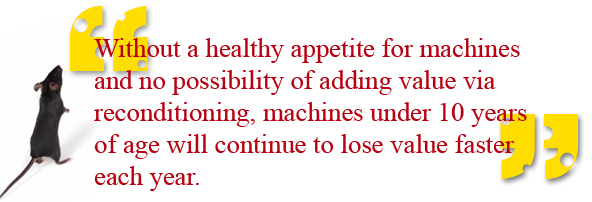Back in 1996, my company needed additional short-term warehouse space, because our new building was
not yet complete and the existing space was full of inventory. We found some industrial units and arranged a month-to-month lease, despite an odd smell emanating from the units. We learned the prior tenant was a spice merchant. No big deal, we thought, the place looked clean.
A few weeks later, I visited the unit and noticed most of the saw cuts in the concrete floor were disturbed, as if someone tried to brush the dirt out of them. It turned out that the spice merchant also attracted mice and when he left so did the food supply. The mice were rummaging in the cracks of the floor looking for food and eventually spread throughout the other units, causing a lot of angry calls to the landlord. It reminded me of the printing industry, analogous to what appears like a desperate skirmish of survival through attrition and the hunt for new revenue streams.
At a recent American Society of Appraisers (ASA) conference in Cleveland, I was asked to make a presentation on our printing industry. It was quite obvious everyone in attendance had received the mainstream memo since numerous questions afterward were about the viability of printing. As many of you know, sometimes messages to outsiders of print tend to be in the very least distorted if not flat-out false. In this particular case, all the attendees work in the banking or valuation field, and the questioning was based on machinery values and how to tabulate obsolescence in an eroding industry. The appraisers did tend to look at print in terms of newspapers, but I went to great
lengths to explain that newspapers and the rest of the industry have little in common. Although struggles abound in both, print’s world includes many essential products not duplicated as of yet.
I brought along some facts and figures from the ibisworld.doc entitled "Out of Print: The Industry Struggles As Printed Media Lose Consumers to The Web”. Although it pertains to the U.S.A., there is validity for the first world as a whole. Essentially, the write-up shows a -6.2% percentage drop in annual negative growth from 2007 to 2012, with a further estimated annual retraction of -1.8% from 2012 to 2017. With 2012 revenue of $76.6 bn, there was a profit of $3.1 bn. That’s only a margin of 4% for the 26,000 businesses in the U.S.A. that call themselves printers.
These figures won’t surprise many of us. For that matter, none of the capital equipment suppliers won’t be stunned either. There is little doubt the reduction in volumes and eroding profitability have been the key reasons why sales of machinery – new technology equipment - has not resumed after the 2008 crash. This clearly tells us that it never will. There are still huge over-capacities in an industry that is suffering at the hands of tablets, smart phones and the internet. With the majority of firms operating on slim returns, it’s left to a small select group who continually upgrade and add technology and services. They seek to partner with the giant marketing industry in symbiosis.
Everyone connected to funding or evaluating assets in the print industry is concerned about its viability. That was made very clear in Cleveland by funders and valuators alike. Veterans were also quick to pick up the serious issue of accurate forced sale versus orderly liquidation assessments. In 2007, there was a distinct difference, but not today. The reason is simple. Too much legacy equipment that can no longer be bought and sold in local markets. Without a healthy appetite for machines and no possibility of adding value via reconditioning, machines under 10 years of age will continue to lose value faster each year.

About the only bright light in the world of print is packaging. This term incorporates a lot of allied industries - labels, carton, corrugated, POS (Point Of Sale), and flexible. There is no sign that packaging will retract in the future and that bodes well for board suppliers, mills and printers. But, can we all get into packaging and, if so, would that not cause margins to fall, much in the way that quick-printing with toner devices and now large-format production have already started to lose their high margins?
Of all the print industry’s sectors, packaging is the closest to the true definition of manufacturing. From the 64- inch format down to 41-inch format, the current volume will support most of the businesses currently playing in the sector, which is relatively small on a per-company count. How much more capacity does this sector need? I think not much. These folks are buying machinery and often. Consider that four-percent net return for a moment. If IBISWorld is correct, then four-percent is a blend of all sectors, including packaging. This is disturbing considering the packaging sector has higher net returns and generally more stable customers. The question worth asking is: What is the net return average for the commercial sector without packaging?
|


